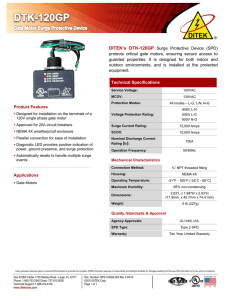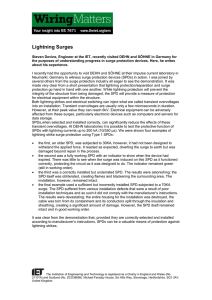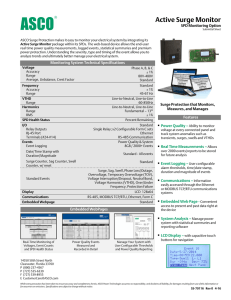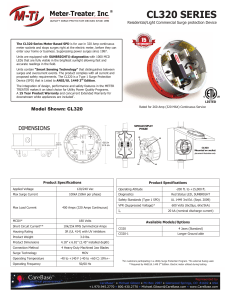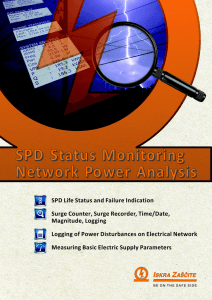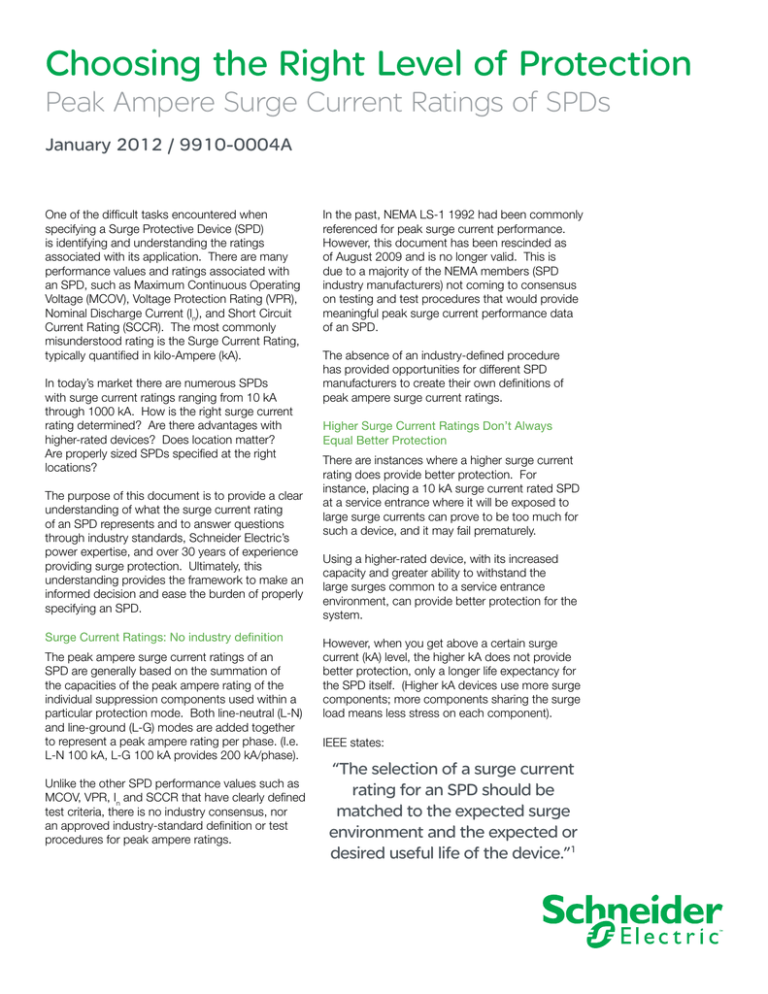
Choosing the Right Level of Protection
Peak Ampere Surge Current Ratings of SPDs
January 2012 / 9910-0004A
One of the difficult tasks encountered when
specifying a Surge Protective Device (SPD)
is identifying and understanding the ratings
associated with its application. There are many
performance values and ratings associated with
an SPD, such as Maximum Continuous Operating
Voltage (MCOV), Voltage Protection Rating (VPR),
Nominal Discharge Current (In), and Short Circuit
Current Rating (SCCR). The most commonly
misunderstood rating is the Surge Current Rating,
typically quantified in kilo-Ampere (kA).
In today’s market there are numerous SPDs
with surge current ratings ranging from 10 kA
through 1000 kA. How is the right surge current
rating determined? Are there advantages with
higher-rated devices? Does location matter?
Are properly sized SPDs specified at the right
locations?
The purpose of this document is to provide a clear
understanding of what the surge current rating
of an SPD represents and to answer questions
through industry standards, Schneider Electric’s
power expertise, and over 30 years of experience
providing surge protection. Ultimately, this
understanding provides the framework to make an
informed decision and ease the burden of properly
specifying an SPD.
Surge Current Ratings: No industry definition
The peak ampere surge current ratings of an
SPD are generally based on the summation of
the capacities of the peak ampere rating of the
individual suppression components used within a
particular protection mode. Both line-neutral (L-N)
and line-ground (L-G) modes are added together
to represent a peak ampere rating per phase. (I.e.
L-N 100 kA, L-G 100 kA provides 200 kA/phase).
Unlike the other SPD performance values such as
MCOV, VPR, In and SCCR that have clearly defined
test criteria, there is no industry consensus, nor
an approved industry-standard definition or test
procedures for peak ampere ratings.
In the past, NEMA LS-1 1992 had been commonly
referenced for peak surge current performance.
However, this document has been rescinded as
of August 2009 and is no longer valid. This is
due to a majority of the NEMA members (SPD
industry manufacturers) not coming to consensus
on testing and test procedures that would provide
meaningful peak surge current performance data
of an SPD.
The absence of an industry-defined procedure
has provided opportunities for different SPD
manufacturers to create their own definitions of
peak ampere surge current ratings.
Higher Surge Current Ratings Don’t Always
Equal Better Protection
There are instances where a higher surge current
rating does provide better protection. For
instance, placing a 10 kA surge current rated SPD
at a service entrance where it will be exposed to
large surge currents can prove to be too much for
such a device, and it may fail prematurely.
Using a higher-rated device, with its increased
capacity and greater ability to withstand the
large surges common to a service entrance
environment, can provide better protection for the
system.
However, when you get above a certain surge
current (kA) level, the higher kA does not provide
better protection, only a longer life expectancy for
the SPD itself. (Higher kA devices use more surge
components; more components sharing the surge
load means less stress on each component).
IEEE states:
“The selection of a surge current
rating for an SPD should be
matched to the expected surge
environment and the expected or
desired useful life of the device.”1
2
Choosing the Right Level of Protection
Comparing two different automotive tires that have
identical specifications except for their mileage
ratings could be similar to comparing two SPDs
with identical specifications except for their high
kA ratings. One tire may be rated for 25,000 miles
while another tire is rated for 50,000 miles. Both
tires provide the same traction (performance) in
different weather conditions and provide maximum
control of the vehicle. The only difference is that
under normal driving conditions it is expected that
the higher rated tire will get twice as many miles of
service. It is largely the same with SPDs, a larger
surge current (kA) rated device is expected to have
a longer active life.
a 100 kA stroke at a utility pole will divide and
take multiple directions seeking a path to ground.
One should not expect the entire transient to be
focused directly at one building.
The example shows that a 100 kA lightning stroke
could result in 30 kA of surge current at the service
entrance to a facility (30% of original current).
Transient Size: What can you expect?
The size of any single internal or external transient
will vary depending on its source and location
within the electrical distribution system.
Per IEEE C62.41.2-2002, the levels of exposure
within a particular surge environment based on
location within the electrical system are:
Category C Service Entrance 10 kV, 10 kA
Category B Distribution
6 kV, 3 kA
Category A Point of use
6 kV, 0.5 kA
When asked, “What is the number one cause
of transients?” lightning is the most common
answer. However, studies show that the majority
of all transients (80%) are being generated inside a
facility while only 20% are coming externally from
the utility side.
While the externally sourced transients are
definitely the more destructive type (Category
C), the more common internally generated
transients (Categories B and A) are slowly wearing
down the systems integrity, and affecting the
performance and life expectancy of the down
stream equipment. When looking at a complete
solution, both internal and external transients must
be addressed.
IEEE identifies possible scenarios whereby external
transient voltage and currents can be introduced
into a system. In addition, it identifies the
associated current that could be seen at the utility
secondary distribution system feeding the service
entrance of a facility.
Annex A.2.1 of IEEE C62.41.1-2002 (Figure 1)
describes the scenario of a direct lightning strike
terminating on the conductors of an overhead
secondary distribution system. In this scenario,
Figure 1: IEEE C62.41.1-2002, Annex A.2.1
How frequent are these lightning strokes that
contain large amounts of current? Data from IEEE
shows that only 5% of all strikes would reach or
exceed peak currents of 100 kA. The majority
of lightning strikes vary from a few kilo amperes
through the median values of 20 kA.
Schneider Electric’s own Lightning Study2 supports
the findings within the IEEE data.
Large transient surge currents typically associated
with a lightning stroke are very rare. They are so
rare that IEEE indicates that the probability of 100
kA or greater impulse striking any particular utility
distribution line or pole would be 1 per 8,000
years.3
Annex A of IEEE C62.41.1-2002 also provides
information demonstrating the physical
impossibilities for high surge currents making it to
the point of the SPD or into a building. Since the
basic insulation level (BIL) of a typical electrical
system is approximately 6,000 volts, the high
voltages that accompany high surge currents will
flash over prior to reaching the SPD.4
From these scenarios it is clear that higher-rated
surge current (kA) devices offer no real benefit over
lower-rated devices when comparing their abilities
Schneider Electric USA, Inc. 1751 S. 4800 W., Salt Lake City, UT 84104, USA
Document Number 9910-0004A
Telephone: (801)-977-9009
Fax: (801)-977-0200
www.surgelogic.com
January 2012
bt
3
Choosing the Right Level of Protection
to shunt large amounts of current. This is due to
limiting factors within the distribution system that
keep the SPD from experiencing extreme currents.
The advantage of the higher-rated device is the
ability to handle more transient surge events over
time, not necessarily larger individual transient
surge events.
How to Properly Size SPDs
There is very little published data or even
recommendations on what level of surge
current (kA) rating should be used in the
different categories or locations. IEEE has
provided some input on what surge ratings
are, and how to interpret them, but does not
publish recommendations. Also, there is not a
proven equation or calculator available to input
system requirements and receive a solution.
Any information a manufacturer provides,
via calculators or other means is merely their
recommendation.
As a result of its many years of knowledge,
experience and expertise in the energy solutions
industry, Schneider Electric has generated an
SPD Application Guideline; a strait forward, simple
approach to applying surge current ratings (Table 1).
To optimize the level of suppression throughout a
system, SPDs should be installed at all levels of
the distribution system. This is known in the SPD
industry as cascading (or layering).
Choosing the appropriate Surge Rating for an SPD
comes down to two things:
1) The location of the SPD within the
electrical distribution, and;
2) The location of the facility
(environmental surroundings)
Cascaded surge protection provides additional
suppression from large transients that step their
way through from the service entrance by reducing
the let-through voltages even more. It also
provides suppression from the more frequently
generated internal transients.
The surge environments for these cascaded SPDs
are not as harsh (Cat B and A) as if located on
the service entrance (Cat C), therefore, the surge
ratings of these downstream SPDs should be
reduced (refer to Table 1).
To summarize the information in Table 1, Schneider
Electric recommends the following surge current
ratings based on SPD location within the electrical
distribution.
Service Entrance Locations
Distribution Locations
Branch Locations
240 kA
120-160 kA
50-120 kA
Earlier discussions highlight the fact that larger
more destructive surge currents are mostly found
at the facility service entrance. On very rare
occasions, for example if the exposure level is
‘Extreme’ (e.g. rural Florida), it might be wise to
increase surge current ratings. Not that the SPD
will be exposed to larger surge current events, but
the SPD can be exposed to more surge events
before it needs to be replaced.
Schneider Electric’s experience shows that a
device carrying a surge current rating of 240-250
kA provides many years of service in the ‘High to
medium’ exposure locations.
Conclusion
The primary purpose of an SPD is to shunt and
suppress the transient voltages that are being
introduced into an electrical system from either an
external or internal source. Selecting the proper
surge current (kA) rated SPDs throughout the
electrical distribution system provides the best
performance life for equipment.
Remember – Disturbance
from within a Facility (80%)
Keep in mind:
L
SPD
•
SPD
SPD
SPD
Load
N
Service Entrance
Distribution
Figure 2: Cascaded Surge Suppression
Branch
Point of Use
Providing proper surge suppression to a
facility and the equipment within requires
more than a single SPD located at the service
entrance. Schneider Electric recommends
cascaded SPDs and a proper surge current
rating for each location. This will provide
superior suppression. A single SPD, no matter
Schneider Electric USA, Inc. 1751 S. 4800 W., Salt Lake City, UT 84104, USA
Document Number 9910-0004A
Telephone: (801)-977-9009
Fax: (801)-977-0200
www.surgelogic.com
January 2012
bt
4
Choosing the Right Level of Protection
•
Over-sizing an SPD for its application cannot
hurt a system, yet under-sizing the SPD can
result in premature failure of the SPD, leaving
systems exposed to transients and their
effects.
•
For direct lightning strikes, SPDs alone are not
a replacement for a comprehensive lightning
protection system (required for UL96A Master
Lightning Certification).
References
1. IEEE C62.72-2007, Sec 16.5
2. SE Lightning Study – 1300DB1101
3. IEEE C62.41.1-2002, Annex A.2.1.1
4. IEEE C62.41.1-2002, Annex A.2.1.3
© 2012 Schneider Electric. All rights reserved.
The Schneider Electric logo and I-Line are trademarks owned by Schneider Electric Industries SAS or its affiliated companies. All other trademarks are the property of their respective owners.
how big or expensive, will not provide the
same level of system protection.
Following the Schneider Electric Application
Guidelines for sizing and placing SPDs throughout
an electrical distribution system (Table 1) takes
the guess work out of selecting the appropriate
SPDs for the appropriate locations and maximizes
your surge suppression at every point. Remember,
bigger isn’t always better.
Table 1: Application Guidelines
Exposure Level
Surge Rating
Environment
Internal Mount
External Mount
Extreme
480 kA
320 kA
• Larger ampacity service entrance
• Extreme lightning area
• Other large industries in area
• Large facility in rural locations
• Switchboard
• Switchgear
• Modular (EMA)
High to medium
240 kA
160 kA
• High lightning areas
• High to medium ampacity service entrance
• Service entrance switchboards
• Service entrance panelboards
•
•
•
•
Switchboard
Switchgear
MCC
I-LineTM/QMB Panel
• Modular (EMA)
• Brick (EBA)
Medium
160 kA
• Distribution switchboards
• Branch circuits not protected by a
•
•
•
•
•
Switchboard
MCC
I-Line/QMB Panel
NQ/NF Panel
Busway
• Modular (EMA)
• Brick (EBA)
Switchboard
MCC
I-Line/QMB Panel
NQ/NF Panel
Busway
• Modular (EMA)
• Brick (EBA)
SPD at service entrance
• Panels feeding heavy industrial motors
• Branch circuits feeding loads outside
the facility
Medium to low
Low
160 kA
120 kA
• Computer equipment loads
• Branch circuits with no upstream
•
•
•
•
•
120 kA
100 kA
80 kA
50 kA
• Branch circuits well inside the facility
• Branch circuits with very sensitive loads and
• NQ/NF Panel
surge suppression
upstream surge suppression
Schneider Electric USA, Inc. 1751 S. 4800 W., Salt Lake City, UT 84104, USA
Document Number 9910-0004A
Telephone: (801)-977-9009
Fax: (801)-977-0200
• Modular (EMA)
• Brick (EBA)
• Nipple Mount (HWA)
www.surgelogic.com
January 2012
bt

